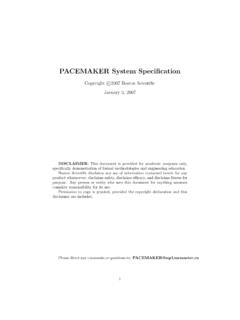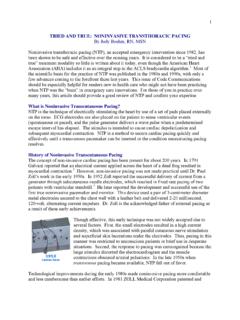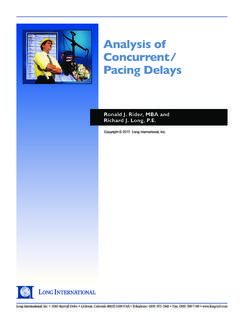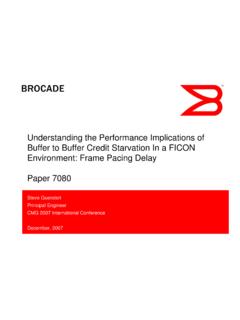Transcription of Pacing Codes and Modes Concepts - SQRL - Home
1 Pacing Codes and Modes ConceptsPacing Codes and Modes conceptsObjectivesUpon completion of this program the participant will be able to: State what the first four positions of the NBG code represent. Explain the concept and benefits of AV synchrony and identify which Pacing mode(s) will maintain AV synchrony. List two single chamber and two dual chamber Pacing modalities and explain the behavior of each. Briefly describe Pacemaker Syndrome and list three possible NGB code Single-and Dual-Chamber Modes Rate Response Choosing a Pacing Mode AV Synchrony Pacemaker SyndromeThe NASPE/BPEG Generic ( )The NASPE/BPEG generic (NBG) codeThe NASPE/BPEG Generic (NBG) CodePositionCategoryLettersUsedManufac-t urer sDesignationOnlyIIIIIIC hamber(s)PacedChamber(s)SensedResponseto SensingProgrammability,rate modulationAntitachy-arrhythmiaFunction(s )O-NoneP-SimpleProgrammableM-Multi-Progr ammableC-CommunicatingR-RatemodulationO- NoneA-AtriumV-VentricleD-Dual(A+V)S-Sing le(A or V)S-Single(A or V)O-NoneA-AtriumV-VentricleD-Dual(A+V)O- NoneT-TriggeredI-InhibitedD-Dual(T+I)
2 O-NoneP- Pacing (antitachy-arrhythmia)S-Sh ockD-Dual(P+S)IVVThe NASPE/BPEG Generic (NBG) CodePositionCategoryLettersUsedManufac-t urer sDesignationOnlyIIIIIIC hamber(s)PacedChamber(s)SensedResponseto SensingProgrammability,rate modulationAntitachy-arrhythmiaFunction(s )O-NoneP-SimpleProgrammableM-Multi-Progr ammableC-CommunicatingR-RatemodulationO- NoneA-AtriumV-VentricleD-Dual(A+V)S-Sing le(A or V)S-Single(A or V)O-NoneA-AtriumV-VentricleD-Dual(A+V)O- NoneT-TriggeredI-InhibitedD-Dual(T+I)O-N oneP- Pacing (antitachy-arrhythmia)S-Shock D-Dual(P+S)IVVThe NASPE/BPEG Generic (NBG) CodePositionCategoryLettersUsedManufac-t urer sDesignationOnlyIIIIIIC hamber(s)PacedChamber(s)SensedResponseto SensingProgrammability,rate modulationAntitachy-arrhythmiaFunction(s )O-NoneP-SimpleProgrammableM-Multi-Progr ammableC-CommunicatingR-RatemodulationO- NoneA-AtriumV-VentricleD-Dual(A+V)S-Sing le(A or V)S-Single(A or V)O-NoneA-AtriumV-VentricleD-Dual(A+V)O- NoneT-TriggeredI-InhibitedD-Dual(T+I)O-N oneP- Pacing (antitachy-arrhythmia)S-Shock D-Dual(P+S)IVVThe NASPE/BPEG Generic (NBG) CodePositionCategoryLettersUsedManufac-t urer sDesignationOnlyIIIIIIC hamber(s)PacedChamber(s)SensedResponseto SensingProgrammability,rate modulationAntitachy-arrhythmiaFunction(s )
3 O-NoneP-SimpleProgrammableM-Multi-Progra mmableC-CommunicatingR-RatemodulationO-N oneA-AtriumV-VentricleD-Dual(A+V)S-Singl e(A or V)S-Single(A or V)O-NoneA-AtriumV-VentricleD-Dual(A+V)O- NoneT-TriggeredI-InhibitedD-Dual(T+I)O-N oneP- Pacing (antitachy-arrhythmia)S-Shock D-Dual(P+S)IVVThe NASPE/BPEG Generic (NBG) CodePositionCategoryLettersUsedManufac-t urer sDesignationOnlyIIIIIIC hamber(s)PacedChamber(s)SensedResponseto SensingProgrammability,rate modulationAntitachy-arrhythmiaFunction(s )O-NoneP-SimpleProgrammableM-Multi-Progr ammableC-CommunicatingR-RatemodulationO- NoneA-AtriumV-VentricleD-Dual(A+V)S-Sing le(A or V)S-Single(A or V)O-NoneA-AtriumV-VentricleD-Dual(A+V)O- NoneT-TriggeredI-InhibitedD-Dual(T+I)O-N oneP- Pacing (antitachy-arrhythmia)S-Shock D-Dual(P+S)IVVThe NASPE/BPEG Generic (NBG) CodePositionCategoryLettersUsedManufac-t urer sDesignationOnlyIIIIIIC hamber(s)PacedChamber(s)SensedResponseto SensingProgrammability,rate modulationAntitachy-arrhythmiaFunction(s )O-NoneP-SimpleProgrammableM-Multi-Progr ammableC-CommunicatingR-RatemodulationO- NoneA-AtriumV-VentricleD-Dual(A+V)S-Sing le(A or V)S-Single(A or V)O-NoneA-AtriumV-VentricleD-Dual(A+V)O- NoneT-TriggeredI-InhibitedD-Dual(T+I)O-N oneP- Pacing (antitachy-arrhythmia)S-Shock D-Dual(P+S)IVVC odes are combined to describe.
4 The mode of Pacing The mode of sensing How the pacemaker will respond to the presence or absence of intrinsic beats AOO AAI VOO VVIVOOV entricular lead Ventricular Pacing Ventricular asynchronous Pacing at lower programmed Pacing rate* No sensingVVI* Sensed intrinsic QRS inhibits ventricular Pacing Ventricular Pacing Ventricular sensingVentricular leadIAOO*Atrial lead Atrial asynchronous Pacing at lower programmed Pacing rate Atrial Pacing No sensingAAI Atrial Pacing *Atrial lead Atrial sensing Intrinsic P wave inhibitsatrial pacingDual Chamber ModesTracking modesDDD**Atrial leadVentricular Lead Pacing in both the atriumand ventricle Sensing in both the atrium and ventricle Intrinsic P wave and intrinsic QRS can inhibit Pacing Intrinsic P Wave can trigger a paced QRSIT / IDDD Pacing Dual-chamber Pacing capable of Pacing and sensing in both the atrial and ventricular chambers of the heart 4 distinct patterns can be observed with DDD Pacing Sensing in the atrium and sensing in the ventricle Pacing in the atrium and sensing in the ventricle Sensing in the atrium and Pacing in the ventricle ( P wave tracking ) Pacing in the atrium and Pacing in the ventricleDDD pacingExample of sensing in both the atrium and the ventricle (inhibiting in both the atrium and the ventricle)
5 DDD pacingExample of Pacing in the atrium with sensing (inhibition of Pacing ) in the ventricleDDD pacingExample of sensing in the atrium (inhibition of atrial Pacing ) and Pacing in the ventricle Also known as P wave tracking DDD pacingExample of atrial Pacing and ventricular Pacing (no inhibition of Pacing )DDD mode Adapts to changes post-implant May resemble AAI, VAT, VDD, DVI Modes Will strive to maintain AV synchrony with variable atrial rates and AV conductionVDDA trialLeadVentricularLead Pacing in ventricle Sensing in both atriumand ventricle Intrinsic QRS inhibitsventricular Pacing Intrinsic P wave cantrigger ventricular Pacing *TIVDD Pacing Able to trigger a ventricular Pacing output in response to an intrinsic P wave ( P wave tracking ) Able to inhibit a ventricular Pacing output in response to an intrinsic QRS complex No atrial Pacing .
6 The patient must have normal sinus node functionNon-tracking modesDDI*I* Sensing in both atrium and ventricle NO tracking of P waves(no constant AV delay) Pacing in the atrium & ventricle**AtrialLeadVentricularLeadIDDI Pacing Never trigger (start) an AV delay following an intrinsic P wave. (No P wave tracking) Similar to combining AAI and VVI Modes Used primarily for atrial tachyarrhythmias and mode switching algorithmsDOO Pacing in atrium and ventricle**VentricularLeadAtrial Lead Intrinsic P wave and QRS do not affect Pacing Asynchronous Pacing (always pace at lower Pacing rate)Rate modulation/rate responsive modeRate responsiveness/adaptive-rate Pacing In Rate Responsive Pacing ( Modes ending with R ), sensor(s) in pacemaker are used to detect changes in physiologic needs and increase the Pacing rate accordingly The sensor Sensors are used to detect changes in metabolic demand Sensors sense motion (piezoelectric crystal or accelerometer)
7 Or use a physiologic indicator, , minute ventilation The algorithm Within the software of the pacemaker Uses the input from the sensor to determine the appropriate paced heart rate for the activityDDDR pacingExample of Dual-Chamber Rate-Responsive pacingDDDRA DDDR pacemaker has two or more indicators of a patient s metabolic need: Sinus node the best indicator, as it is physiologic Input from the sensor(s) within the pacemakerAtrialfibrillation with A-V blockVVIRG oals of choosing a Pacing mode Desire to maintain AV synchrony DDD mode is best to provide AV synchrony Preservation of AV synchrony requires: Viable atrium and Patient must not have chronic/permanent atrialtachyarrhythmiasOptimal Pacing mode decision treePacemaker is indicatedIs the patientchronotropically incompetent?
8 Is the patientchronotropically incompetent?YNChronic atrial fibrillationunexcitable atriumWhat is the condition of the SA Node?Is AV conductionadequate?Is the patientchronotropically incompetent?Is the patientchronotropically incompetent?YNNYYNN ormal or sinusbradycardiaYNDDDRDDDVVIRVVIDDDRDDDA AIRAAI VentricularPacing AV SynchronyAV SynchronyAV synchrony -DDD(R) Benefits AV synchrony Normal sinus response Risks Loss of AV conductionPacemaker is indicatedWhat is the condition of the SA node??Normal or sinusbradycardiaIs AV conductionadequate?Is the patientchronotropically incompetent?NYNDDDRDDD Ventricular pacingPacemaker is indicatedIs the patientchronotropically incompetent?
9 YNChronic atrial fibrillationunexcitable atrium Benefits Maintain minimum cardiac output Single-lead implantation Risks Loss of AV synchrony Retrograde conduction Increased incidence of atria arrhythmias What is the condition of the SA node?VVIRVVIAV synchronyCardiac Output = Stroke Volume x Heart Rate Facilitates venous return Increases LVEDP Maintains appropriate opening and closing of A-V valvesPacemaker syndromeLoss of AV Synchrony Shortness of breath Fatigue Headache Syncope Vertigo CHF, Pulmonary Edema Dizziness Palpitations Pulsations in the neck Chest pain Near Syncope ConfusionHemodynamic Penalties From Loss Of AV SynchronyTreatment of Pacemaker Syndrome Dual-chamber Pacing Normal atrial sensing & capture Appropriate AV Delay Loss of atrial contribution Decrease in stroke volume Decrease in cardiac output Decrease in cerebral perfusion Decrease in coronary blood flowSummaryWhat was the mode of the first permanent pacemakers?
10 VOOWhat mode and feature are designed to most effectively mimic the normal cardiac conduction? DDD and rate-adaptive pacingName 5 symptoms of pacemaker syndrome. Palpitations, Canon A waves, fatigue, near syncope, Codes and Modes Concepts







